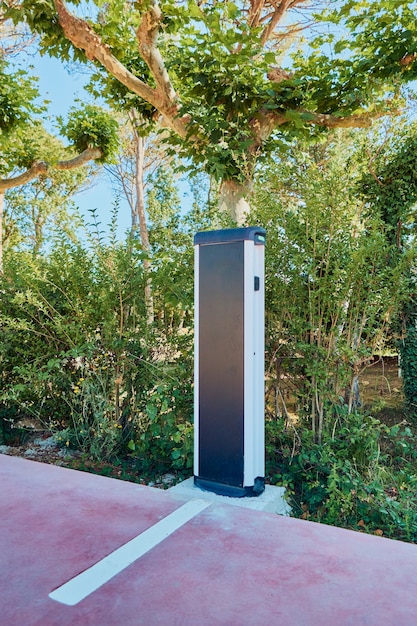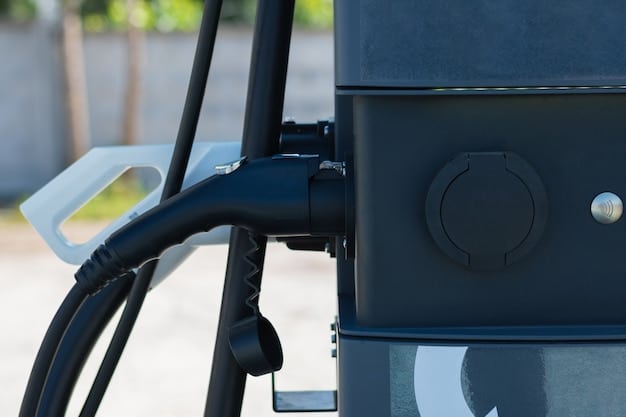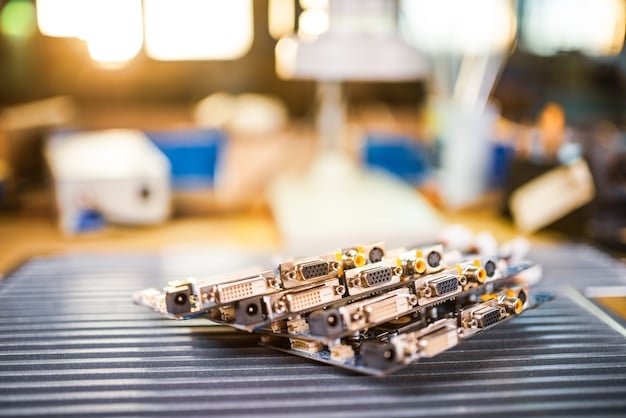Inflation Reduction Act: Impact on US Electric Vehicle Market

The Inflation Reduction Act of 2022 significantly reshapes the US electric vehicle (EV) market by offering substantial tax credits and incentives, influencing consumer behavior, manufacturer strategies, and infrastructure development.
The EV sector in the United States is undergoing a transformation, largely fueled by policy changes such as the **Understanding the Implications of the Inflation Reduction Act on the US Electric Vehicle Market**. This legislation aims to accelerate the adoption of electric vehicles through a series of incentives and tax credits, poised to reshape the automotive landscape.
The Inflation Reduction Act: An Overview
The Inflation Reduction Act (IRA), signed into law in August 2022, represents a landmark investment in clean energy and climate change mitigation. Its provisions extend far beyond just electric vehicles, but the impact on the EV market is particularly noteworthy. The act aims to reduce carbon emissions and stimulate domestic manufacturing through a variety of financial incentives.
The core objective is to make electric vehicles more accessible and affordable to American consumers, while simultaneously encouraging the growth of a domestic EV supply chain. Let’s delve into the specifics of how this legislation is structured and its potential effects.
Key Provisions of the IRA Affecting EVs
Several sections of the Inflation Reduction Act are crucial for understanding its influence on the EV market. These include the revamped electric vehicle tax credit, the establishment of new manufacturing incentives, and funding for charging infrastructure.
- Tax Credits for New and Used EVs: The IRA offers a tax credit of up to $7,500 for new electric vehicles and $4,000 for used EVs, subject to certain income and vehicle price limitations.
- Domestic Manufacturing Incentives: The act includes provisions to incentivize the domestic production of EV batteries and critical minerals, aiming to reduce reliance on foreign supply chains.
- Charging Infrastructure Funding: Significant funding is allocated to expand the network of electric vehicle charging stations across the country, addressing a major barrier to EV adoption.
These provisions work in concert to create a more favorable environment for electric vehicle adoption in the US, driving demand and fostering industry growth.
In conclusion, the Inflation Reduction Act’s framework supports a long-term vision for electric vehicle market growth in the US, emphasizing affordability, domestic manufacturing, and infrastructure development to drive demand and stimulate innovation.

Impact on Consumer Behavior and EV Adoption
The most immediate impact of the Inflation Reduction Act is on consumer behavior. By offering substantial tax credits, the act directly influences purchasing decisions, potentially accelerating the transition from gasoline-powered vehicles to electric alternatives. Understanding these incentives is critical for predicting market trends.
The tax credits significantly lower the upfront cost of EVs, making them more competitive with traditional vehicles. However, several factors determine eligibility and the actual value of the credit received.
Understanding the Tax Credit Requirements
To qualify for the full $7,500 tax credit, EVs must meet certain requirements related to battery components and critical mineral sourcing. The vehicle must undergo final assembly in North America, and a percentage of the battery’s components and critical minerals must be sourced from the US or its free trade partners.
Additionally, there are income limitations for buyers. The modified adjusted gross income (MAGI) cannot exceed $300,000 for married couples filing jointly, $225,000 for heads of households, and $150,000 for single filers. The vehicle’s price must also be below certain thresholds, such as $80,000 for SUVs, trucks, and vans, and $55,000 for cars.
Exploring consumer perspectives and considerations is vital.
- Consumer Awareness: A significant challenge is ensuring that consumers are aware of the tax credits and understand the eligibility requirements.
- Vehicle Availability: The availability of EVs that meet the sourcing requirements may be limited initially, affecting the immediate impact of the tax credits.
- Infrastructure Concerns: While the IRA addresses charging infrastructure, consumer perceptions about the availability and reliability of charging stations remain a factor in their purchase decisions.
These factors play a crucial role in determining the extent to which the Inflation Reduction Act will influence consumer behavior and accelerate EV adoption rates in the US. Over time, as more vehicles meet the eligibility requirements and the charging infrastructure expands, the impact of the act is expected to grow.
To summarize, the IRA affects consumers through financial incentives balanced with eligibility considerations, infrastructure improvements, and market readiness to truly shape EV adoption.
Manufacturer Strategies and Supply Chain Adjustments
The Inflation Reduction Act is not only influencing consumer behavior but also prompting significant strategic shifts among automakers. To capitalize on the incentives and comply with the requirements, manufacturers are reevaluating their supply chains and investment strategies.
The domestic manufacturing incentives included in the IRA are designed to reduce reliance on foreign suppliers, particularly China, for critical minerals and battery components. This is leading to a surge in investments in domestic battery production and mineral processing.
Adapting to Domestic Sourcing Requirements
Automakers are actively seeking partnerships with domestic suppliers of battery materials, such as lithium, nickel, and cobalt. They are also investing in new facilities to process these materials in the US, aiming to meet the IRA’s sourcing requirements for tax credit eligibility.
However, adapting to these requirements presents challenges. Establishing a robust domestic supply chain takes time and requires significant capital investment. Some manufacturers may initially struggle to meet the sourcing thresholds, potentially limiting the number of vehicles that qualify for the full tax credit.
Assessing manufacturer strategies and supply chain impact can be broken down into several key points:
- Investment in US Manufacturing: Automakers are announcing new EV and battery manufacturing facilities in the US, creating jobs and boosting the domestic economy.
- Partnerships with Mining Companies: Manufacturers are forging partnerships with mining companies to secure access to critical minerals sourced from the US or its free trade partners.
- Technological Innovation: The IRA is incentivizing innovation in battery technology, with manufacturers exploring alternative battery chemistries that rely on more readily available materials.
By adjusting their supply chains and investing in domestic manufacturing, automakers are positioning themselves to take full advantage of the opportunities presented by the Inflation Reduction Act, while also contributing to a more resilient and sustainable EV industry in the US.
In short, manufacturers are pivoting with capital, partnerships, and innovation to make a more sustainable EV industry in the US thanks to the IRA.

Infrastructure Development and Charging Network Expansion
One of the most critical aspects of the Inflation Reduction Act is its focus on expanding the electric vehicle charging infrastructure. The availability of convenient and reliable charging is essential for overcoming range anxiety and encouraging widespread EV adoption.
The IRA allocates significant funding to support the deployment of charging stations across the country, particularly in underserved areas. This includes grants for states and local governments to invest in charging infrastructure, as well as tax credits for businesses and individuals who install charging equipment.
Addressing Charging Infrastructure Gaps
The current charging infrastructure in the US is inadequate to support a rapid increase in the number of EVs on the road. There are gaps in coverage, particularly in rural areas and along major highways. The IRA aims to address these gaps by incentivizing the construction of new charging stations in strategic locations.
The funding provided by the IRA can be used to upgrade existing charging stations, making them faster and more reliable. It can also support the development of new charging technologies, such as wireless charging and ultra-fast charging.
Considering future implications and long-term planning, it’s important to note:
- Public-Private Partnerships: The expansion of the charging network will require collaboration between government agencies, private companies, and utility providers.
- Standardization of Charging Protocols: Efforts are underway to standardize charging protocols, ensuring that EVs can charge at any station regardless of the manufacturer.
- Integration with the Grid: As the number of EVs increases, it will be essential to integrate the charging network with the electric grid, managing demand and ensuring grid stability.
By investing in charging infrastructure, the Inflation Reduction Act is laying the foundation for a future where electric vehicles are a practical and convenient option for all Americans.
As a result of IRA infrastructure focus, the US charging network will be more accessible and stable supporting future EV adoption.
Potential Challenges and Unintended Consequences
While the Inflation Reduction Act holds considerable promise for the EV market, it is essential to acknowledge the potential challenges and unintended consequences that may arise. Policies, while well-intentioned, can sometimes have unforeseen effects that need to be addressed.
One of the main concerns is the complexity of the tax credit eligibility requirements. The sourcing rules, in particular, may prove difficult for some manufacturers to meet, potentially limiting the number of vehicles that qualify for the full credit.
Navigating Complex Regulations
The income limitations for buyers may also exclude some consumers from receiving the tax credit. This could disproportionately affect lower-income households, who may benefit most from the cost savings associated with EVs.
There is also the risk that the increased demand for EVs could strain the supply of critical minerals, leading to higher prices and potential supply chain disruptions. This could undermine the affordability goals of the IRA.
Identifying potential hurdles and mitigation strategies require consideration of the following:
- Supply Chain Bottlenecks: The sourcing requirements could create bottlenecks in the supply of critical minerals, leading to higher costs and delayed production.
- Consumer Confusion: The complexity of the tax credit rules could confuse consumers, leading to frustration and discouraging EV adoption.
- Impact on Used EV Market: The IRA’s tax credit for used EVs could impact the value of older EVs, potentially making them more affordable but also reducing the resale value for current owners.
Addressing these challenges will require ongoing monitoring and adjustments to the IRA’s provisions. It will also require collaboration between government, industry, and consumers to ensure that the act achieves its intended goals.
In summary, thoughtful oversight, flexibility, and adaptation are key to mitigating unforeseen consequences and ensuring its long-term success of the IRA is achieved.
Long-Term Outlook and Future Implications
Looking ahead, the Inflation Reduction Act is expected to have a profound and lasting impact on the US electric vehicle market. By incentivizing EV adoption, stimulating domestic manufacturing, and expanding charging infrastructure, the act is laying the groundwork for a more sustainable and competitive EV industry.
In the coming years, we can expect to see a significant increase in the number of EVs on the road, as well as a shift towards more domestic production of batteries and critical minerals. This will reduce reliance on foreign supply chains and create new jobs in the US.
Shaping the Future of Electric Mobility
The IRA is also likely to accelerate innovation in battery technology, leading to longer ranges, faster charging times, and lower costs. This will make EVs even more attractive to consumers and further drive adoption rates.
The long-term outlook for the EV market in the US is overwhelmingly positive. However, the success of the Inflation Reduction Act will depend on effective implementation and ongoing adjustments to address any challenges that may arise.
Regarding future trends and predictions, it’s worth noting the following :
- Continued Growth in EV Sales: The IRA is expected to fuel continued growth in EV sales, with electric vehicles accounting for an increasing share of the overall auto market.
- Expansion of Charging Infrastructure: The charging network will continue to expand and improve, making it easier for EV owners to charge their vehicles on the go.
- Greater Affordability: As battery costs decline and domestic manufacturing increases, EVs will become more affordable for a wider range of consumers.
By creating a favorable policy environment, the Inflation Reduction Act is positioning the US to be a leader in the global electric vehicle market.
The long-term results of the IRA will be increasing supply, technological advancement, and market penetration on a global scale.
| Key Point | Brief Description |
|---|---|
| 💰 Tax Credits | Up to $7,500 for new, $4,000 for used EVs, based on requirements. |
| 🏭 Manufacturing Incentives | Encourages domestic production of EV batteries and minerals. |
| 🔌 Charging Infrastructure | Funds expansion of EV charging stations nationwide. |
| 🌎 Long-Term Impact | Sustainable EV growth, innovation, and global market leadership. |
Frequently Asked Questions
▼
The Inflation Reduction Act is a US law passed in August 2022, designed to combat climate change and lower healthcare costs. It includes significant investments in clean energy and electric vehicle adoption through various incentives and tax credits.
▼
The IRA offers tax credits of up to $7,500 for new EVs and $4,000 for used EVs, helping to reduce the upfront cost. However, these credits are subject to income and vehicle price limitations, as well as sourcing requirements for battery components and minerals.
▼
To qualify for the new EV tax credit, your modified adjusted gross income (MAGI) must not exceed $300,000 for joint filers, $225,000 for heads of households, or $150,000 for single filers. Similar limits apply for the used EV credit.
▼
The EV must undergo final assembly in North America, and a percentage of its battery components and critical minerals must be sourced from the US or its free trade partners. Price limits also apply: $80,000 for SUVs, trucks, and vans; $55,000 for cars.
▼
The IRA allocates significant funding for grants to states and local governments to invest in charging infrastructure. It also provides tax credits for businesses and individuals who install EV charging equipment, expanding charging station availability.
Conclusion
In conclusion, the Inflation Reduction Act represents a pivotal moment for the US electric vehicle market. It incentivizes consumers, reshapes manufacturer strategies, and supports infrastructure development to transform transportation for the better. While challenges persist, the IRA establishes a framework for sustainable EV growth, positioning the US as a leader in the global transition to electric mobility.





